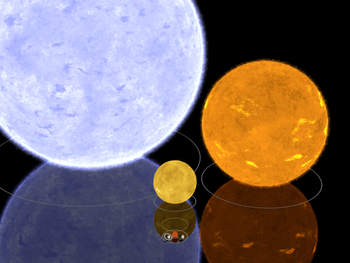
1 E9 m
Encyclopedia

Metre
The metre , symbol m, is the base unit of length in the International System of Units . Originally intended to be one ten-millionth of the distance from the Earth's equator to the North Pole , its definition has been periodically refined to reflect growing knowledge of metrology...
s (1 gigametre
Gigametre
A gigametre is a unit of length in the metric system, equal to one billion meters, the SI base unit of length, hence to 1,000,000 km or approximately 621,370 miles....
(Gm) or 1 million kilometre
Kilometre
The kilometre is a unit of length in the metric system, equal to one thousand metres and is therefore exactly equal to the distance travelled by light in free space in of a second...
s).
Distances shorter than 109 metres
- 1.4 Gm — Diameter of SunSunThe Sun is the star at the center of the Solar System. It is almost perfectly spherical and consists of hot plasma interwoven with magnetic fields...
- 1.5 Gm — (proposed) Expected orbit from Earth of the James Webb Space TelescopeJames Webb Space TelescopeThe James Webb Space Telescope , previously known as Next Generation Space Telescope , is a planned next-generation space telescope, optimized for observations in the infrared. The main technical features are a large and very cold 6.5 meter diameter mirror, an observing position far from Earth,...
- 2.19 Gm — Closest approach of Comet Lexell to EarthEarthEarth is the third planet from the Sun, and the densest and fifth-largest of the eight planets in the Solar System. It is also the largest of the Solar System's four terrestrial planets...
, happened on 1 July 1770; closest cometCometA comet is an icy small Solar System body that, when close enough to the Sun, displays a visible coma and sometimes also a tail. These phenomena are both due to the effects of solar radiation and the solar wind upon the nucleus of the comet...
approach on record - 3 Gm — Total length of "wiring" in the human brain.
- 4.2 Gm — Diameter of Algol B
- 5.0 Gm — Closest approach of Comet HalleyComet HalleyHalley's Comet or Comet Halley is the best-known of the short-period comets, and is visible from Earth every 75 to 76 years. Halley is the only short-period comet that is clearly visible to the naked eye from Earth, and thus the only naked-eye comet that might appear twice in a human lifetime...
to Earth, happened on 10 April 837 - 5.0 Gm — (proposed) Size of the arms of the giant triangle shaped Michelson interferometer of the Laser Interferometer Space AntennaLaser Interferometer Space AntennaThe Laser Interferometer Space Antenna is a planned space mission to detect and accurately measure gravitational waves from astronomical sources. LISA was originally conceived as a joint effort between the United States space agency NASA and the European Space Agency...
(LISA) planned to start observations in or around 2015. - 7.9 Gm — Diameter of Gamma OrionisGamma OrionisBellatrix, also known by its Bayer designation Gamma Orionis , is the third brightest star in the constellation Orion, the twenty-seventh brightest star in the night sky, and one of the brightest second-magnitude stars....
- 9.0 Gm — Estimated diameter of the event horizonEvent horizonIn general relativity, an event horizon is a boundary in spacetime beyond which events cannot affect an outside observer. In layman's terms it is defined as "the point of no return" i.e. the point at which the gravitational pull becomes so great as to make escape impossible. The most common case...
of Sagittarius A*, the supermassive black holeSupermassive black holeA supermassive black hole is the largest type of black hole in a galaxy, in the order of hundreds of thousands to billions of solar masses. Most, and possibly all galaxies, including the Milky Way, are believed to contain supermassive black holes at their centers.Supermassive black holes have...
in the center of the Milky WayMilky WayThe Milky Way is the galaxy that contains the Solar System. This name derives from its appearance as a dim un-resolved "milky" glowing band arching across the night sky...
galaxy
Distances longer than 1010 metres

